Introduction During the month of July, the veterinary team took part in various activities that included veterinary intervention to sick or injured wildlife in Naivasha and Masai Mara
Introduction
During the month of July, the veterinary team took part in various activities that included veterinary intervention to sick or injured wildlife in Naivasha and Masai Mara. The vet was also invited to Uganda for 12 days to participate in a summer school in which there was learning and exchange of ideas on the control and prevention of endemic and zoonotic diseases along Lake Victoria Basin. The biggest challenge was on how to control trypanosomiasis in livestock and humans, control of the spread of this disease from wildlife to livestock is a very important component since wildlife act as reservoir hosts for the trypanosome parasite.
Treatment and desnaring of a common zebra (Equis burchelli) in Oserian farm Naivasha
The animal was reported to have an injury that was caused by a wire snare and it was unable to move and graze freely due to pain and irritation caused by the snare. The veterinary team managed to attend to this case. It was immobilized through darting and the snare was removed and the wound treated accordingly then the zebra was revived from anaesthesia.
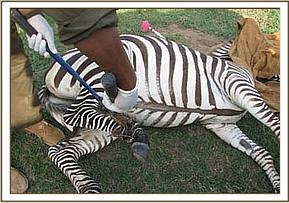
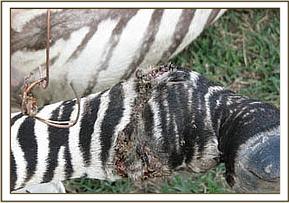


Treatment of a Cheetah in Koiyaki community ranch in Masai Mara
It was an adult female cheetah which was reported to have an injury on the right front limb. The animal was in pain and could not hunt so it was fed on goat meat by the management of Serian camp. It had a yellow ear tag indicated number 51which had stayed on it for some years (probably for monitoring purposes). The animal was then anaesthetized using 80mgs of Xylazine hydrochloride combined with 80mgs Ketamine hydrochloride and it went recumbent after 4 minutes.
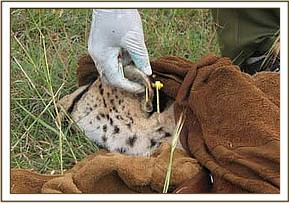
Physical examination and treatment
Clinical observation revealed a lacerative wound on the digital pad of the 3rd digit of right front limb. The wound was already infected through contamination with soil during movement. It was then debrided using 10% hydrogen peroxide then topical application of tincture of iodine and oxytetracycline spray applied. 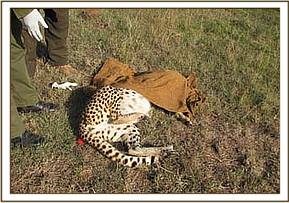
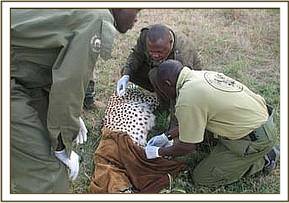

The animal was further treated with Betamox administered intramuscularly, followed by dexamethasone through intramuscular injection. Fipronil (Frontline) spray was applied to control ectoparasites.
Samples collection
Biological samples collected for laboratory analysis were whole blood, serum, hair samples, skin scrapings and blood smears.
Anaesthetic revival
Partial revival of anaesthesia was done by administering 5mgs of Atipamezole hydrochloride through the femoral vein. The animal rose up from anaesthesia after a few minutes. It had good prognosis because the wound was small and well treated.
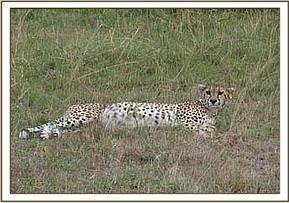
Treatment and sampling a buffalo with skin disease in Masai Mara
This was an adult female buffalo that we found with large alopecic and crusty patches over the back and belly of the animal. It was in a herd of about 50 buffaloes next to KWS research center. We decided to anaesthetize the animal so that the lesions could be examined closely and find out if the condition could be contagious and have a risk of spreading to other buffaloes in the herd. It was then immobilized by darting using 5mgs of etorphine hydrochloride combined with 60mgs of Xylazine hydrochloride. The animal became recumbent after about 5 minutes.
Physical examination and treatment
Wide areas of dry, crusty alopecic patches covering the back, lateral and ventral abdominal regions. This was suspected to be a fungal infection, the animal had almost all the teeth worn out and this could lead to inadequate feeding that resulted to low immunity that favoured opportunistic infection.
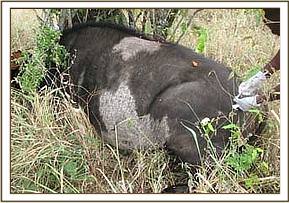
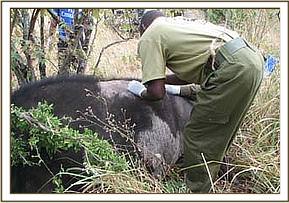
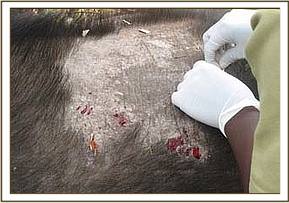

The animal was treated with injectable antibiotics and ivomectin, the patches were treated by topical application of iodine, then fipronil (Frontline) was sprayed on the skin for control of ectoparasites.
Samples collection
Whole blood, serum, scrapings from the lesions and blood smears were collected for further laboratory analysis.
Anaesthetic revival
The animal was revived from anaesthesia using 12 mgs of Diprenorphine hydrochloride combined with 5mgs of Atipamezole hydrochloride and it took about 2 minutes to rise up. The herd will still be monitored closely to check if there is transmission of this condition.
Conclusion
In Masai Mara the veterinarian is expected to set up a functional diagnostic laboratory with basic requirements for preliminary diagnosis of animal diseases. The lab will also act as a center for research on wildlife diseases. It will also help in disease monitoring and surveillance in the wildlife population both within and outside Masai Mara game reserve. This is due to the fact that there is much interaction between wildlife, livestock and human beings around the reserve that can enhance the transmission and spread of these diseases among these species.
Reported by Dr. Domnic Mijele